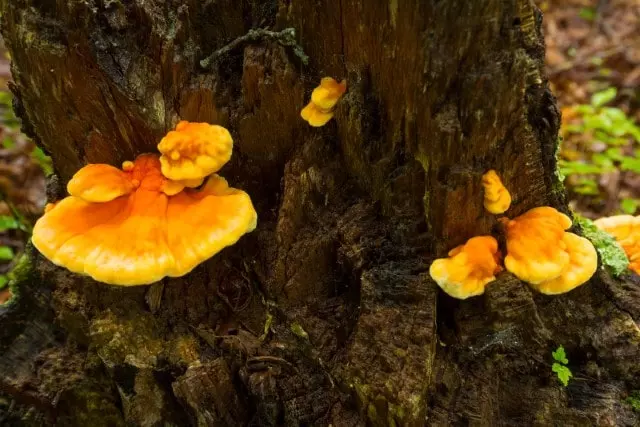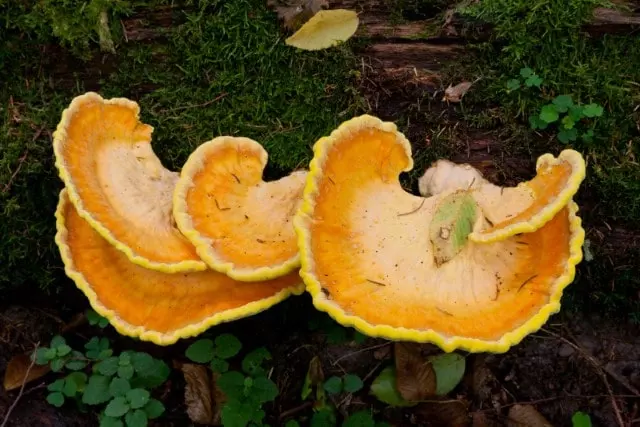There is a non-poisonous yellowish-orange mushroom that tastes like chicken. Sulphur shelf mushroom are large in size, smooth and juicy in texture, and safe to eat. Sulphur shelf mushroom is also known as chicken of the woods, chicken fungus, and chicken mushroom.
These mushrooms provide you with plant-based proteins, vitamins, minerals, and antioxidants with a delicious chicken flavor, adding umami characteristics to dishes.
Sulphur shelf mushroom is different from the classic mushrooms, portobellos, or mushrooms you often find in the supermarket. They are a picker’s delight, and some restaurants prepare delicious dishes with these mushrooms. So, if you find them on a hike, you can take advantage of them and enjoy an extraordinary dish.
Table of Contents
Characteristics to Recognize Sulphur Shelf Mushroom
Sulphur shelf mushroom was first described as “Boletus sulphurei” by the French mycologist Pierre Bulliard in 1789. These mushrooms grow mainly on live or decaying oak trees and can weigh up to 100 lbs. (45 kg). Its appearance is striking, with an orange color (although as it matures it may become brownish) and hardly any height. These mushrooms are usually fan-shaped or even semicircular, and their texture is soft and suede-like.
Shape: Because this mushroom has no stem, it is not tall. It is fan-shaped to semicircular or irregularly shaped and can be smooth to finely wrinkle with a suede-like texture. The cap is 2” to 12” (5 to 30 cm) wide and up to 8” (20 cm) deep; it may be up to 1.2” (3 cm) thick.
Color: When young, it is a brilliant yellow to bright orange (sometimes with a reddish tinge), and after it reaches maturity, it frequently ages and becomes virtually white. When chopped, its color does not alter. When the flesh is young, it is thick, squishy, and extremely watery.
There are many other varieties of orange mushrooms, such as the Sulfur shelf mushroom, but not all are edible. If you want to learn more about orange edible mushrooms follow the link to our most recent post.

Where to Find Sulfur Shelf Mushroom?
Sulphur shelf mushroom grow in North America, Europe, and parts of Asia and feed on trees, dead or alive. Oaks are their favorite trees, although they can also be found in other hardwoods.
These mushrooms which some also find lobster or crab taste are not poisonous, but they do cause terrible damage to trees. The University of Florida explains that “Laetiporus sulphureus” is a parasite that causes the rotting of the host tree.
How to Cook Sulfur Shelf Mushroom
To cook Sulphur shelf mushroom so that they are fully edible, they must pass through the pan. You can cook chicken of the woods mushroom with a little broth or wine to make them taste better, and perhaps we can add other ingredients such as black pepper, cayenne, garlic, and sweet paprika.
When cooking Sulphur shelf mushroom, you must cut the hard part of the mushroom, just where the stem sticks to the tree. Once cut, the mushrooms should be washed well and then dried.
Also, you can “bread” the mushrooms for a delicious recipe. Pass them through flour previously seasoned with paprika and cayenne, as well as a pinch of salt and pepper.
Dredge the mushrooms in the flour, then in the egg, and again in the flour. Heat a frying pan with olive oil and add the mushrooms, some crushed garlic, and some thyme.
Cook until the mushrooms are well browned on both sides (4-5 minutes per side), remove from the pan, leave on a plate with kitchen paper to dry the excess oil, and add some salt, and we can enjoy these chicken-flavored mushrooms.

